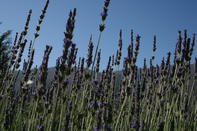Propagation
Lavender propagation is from seed, but this sometimes leads to problems ensuring the true to type seedlings. Lavender for commercial production is best propagated by planting cuttings from reliable source material. Layering or dividing the established plant and planting this out is also done but not on a large scale.

Planting Method
Lavender planting by large commercial growers, is more commonly done, by planting seedlings that have been produced from cuttings in a greenhouse. This gives the grower more control of the plant density and uniformity. The lavender plants can be planted by hand or by a mechanical planter.
Spacing
Plants should be spaced 50 cm apart in rows that are 100 cm to 120 cm apart depending on the variety or the type of machinery used. This is a stand of around 16 000 to 20 000 lavender plants per hectare. Implement and tractor paths are left for management practices and harvesting.
Planting Time
The best planting time for lavender is autumn, therefore, in South Africa late March or early April to ensure that the seedlings develop well before the winter and that by spring they are strong and well established.
Sow lavender seeds into seed trays in a protected environment or greenhouse during June and by early spring the seedlings should be strong enough to plant out into the fields. Seedlings are normally strong enough eight weeks after planting seeds. Seedlings can also be planted in early spring. In South Africa in late August early September after the last frost.
Growth Period
Twelve weeks in a greenhouse should produce strong seedlings from cuttings that are ready to plant out into the fields. Most producers start harvesting lavender during the second year or summer.
In some cases where autumn planting is done the first summer could possibly yield a cut. From the second year, a second harvest can be done before autumn. The second year of harvesting will yield higher productions.
Lavender plants can be harvested for 10 to 12 years if managed properly. Lavender plants like some other herbs become very woody and brittle as they get older so care must be taken to not damage the core of the plant as it could die.
Fertilization
Do not over-fertilize lavender. Before planting, a representative soil sample should be taken and sent for analysis. This will identify soil type and nutrient requirements for the intended crop.
For a rough guide, the following recommendation can be used in the absence of soil analysis. An initial 250 kg application of 3:1:5 can be broadcast and incorporated into the top 20 cm of soil prior to planting the lavender seedlings.
This will give the new seedlings a good start in establishing themselves. During the first 12 months, it is important to keep the plants growing so a further two applications of 200 kg of 3:1:5 can be applied along the plant rows, one in November and another in March. Once harvesting starts it is advisable to fertilize lightly after every harvest cut. With drip irrigation, liquid fertilizer must be applied through the water.
Irrigation
The lavender plant is a semi-hardy plant and does not require a lot of water. If planted without permanent irrigation a rainfall of about 800 mm spread over the year should be sufficient. Installing permanent irrigation does however increase yields where there is no rainfall at regular intervals throughout particularly the summer months.
Drip irrigation is best but do not over-irrigate as this causes root diseases and reduces the quality of the essential oils. Depending on soil types and the weather, irrigation volumes will differ from field to field. A good average is between 15 and 20 mm per week during the warm summer months and reducing or stopping irrigation during cooler or rainy months of the year.
Do not irrigate the week before harvest, but irrigate immediately after harvest to bring soil back to optimum moisture levels to minimize stress. It is advisable to install moisture monitoring devices to continuously monitor the soil.
Weed Control
Controlling the weeds in the plantation is very important. Control by hand or with a mechanical harrow or cultivator. This can also be done by mulching either with plastic ground cover or with vegetative mulching to stop weeds from germinating.
Higher plant densities under drip irrigation, is good for overshadowing the ground and reducing weed emergence. If the growers are distilling their own oil then the waste from distillation can be used as mulching along the plant rows.